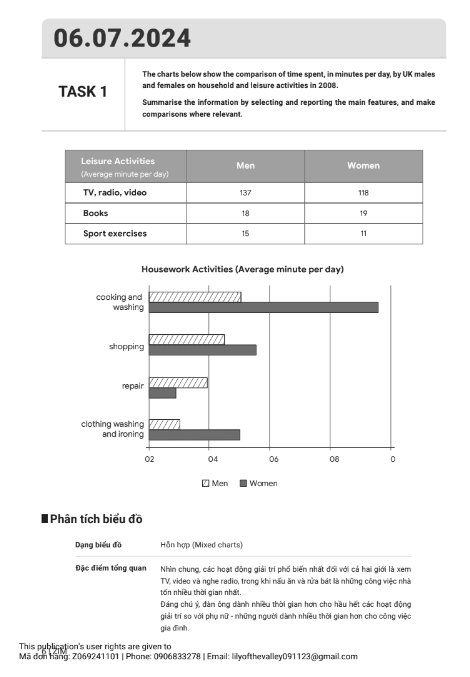


Đoạn 1 – Mô tả và so sánh số liệu của dạng bảng.
• Xét về các hoạt động giải trí, xem TV, video và nghe đài cho đến nay là phổ biến nhất, với nam giới dành nhiều thời gian hơn nữ giới (137 phút so với 118 phút/ngày).
• Một sự khác biệt tương tự, mặc dù ít rõ ràng hơn, cũng được thấy trong thể thao, với mỗi giới dành lần lượt 15 và 11 phút/ngày.
• Tuy nhiên, đọc sách là hoạt động duy nhất mà phụ nữ đầu tư nhiều thời gian hơn nam giới, với con số tương ứng là 19 và 18 phút/ngày.
Đoạn 2 – Mô tả và so sánh số liệu của dạng cột.
• Đối với công việc gia đình, phụ nữ dành nhiều thời gian nhất để nấu ăn và rửa bát, trung bình 75 phút/ngày, gần gấp đôi so với nam giới, khoảng 30 phút.
• Hoạt động tốn nhiều thời gian nhất tiếp theo đối với cả hai giới là mua sắm, với phụ nữ trung bình khoảng 35 và nam giới khoảng 25 phút/ngày.
• Xu hướng này tiếp tục với các công việc liên quan đến quần áo, trong đó phụ nữ dành 30 phút/ngày, gấp ba lần số lượng nam giới làm.
• Ngược lại, lượng thời gian nam giới sửa chữa nhiều gấp đôi so với nữ giới, gần 20 phút/ngày.
The bar chart and table illustrate how much time men and women in the UK allocated to housework and entertainment in 2008. Units are measured in minutes per day (mins/day).
Overall, the most popular leisure activities for both genders were watching TV, videos, and listening to the radio, while cooking and washing dishes were the most time-consuming household chores. Notably, men spent more time on most leisure activities compared to women, who dedicated significantly more time to household tasks.
In terms of recreational pursuits, watching TV, videos, and listening to the radio were by far the most common, with men spending more time than women (137 compared to 118 mins/day). Reading, however, was the only activity in which women invested more time than men, with respective figures of 19 and 18 mins/day.
As for household chores, women devoted the most time to cooking meals and washing dishes, at 75 mins/day on average, approximately double the figure for males, at about 30 minutes. The next most time-consuming activity for both genders was shopping, with women averaging around 35 and men roughly 25 mins/day. This pattern continued with clothes-related chores, where women spent 30 mins/day, three times the amount men did. In contrast, the amount of time men spent on repairs was twice as much as that of women, at nearly 20 mins/day.
Word count: 250
Câu được chọn: “A similar difference, albeit less pronounced, was also seen in sports, with each sex spending 15 and 11 mins/day respectively.”
Cấu trúc câu:
- Chủ ngữ (S): A similar difference
- Mệnh đề phụ: albeit less pronounced
- Động từ (V): was seen
- Bổ ngữ: in sports
- Cụm giới từ: with each sex spending 15 and 11 mins/day respectively
Phân tích chi tiết của các cụm từ trong câu:
- A similar difference – Chủ ngữ
- Albeit less pronounced – Liên từ chỉ sự nhượng bộ
- Was seen in sports – Động từ chính + bổ ngữ
- With each sex spending 15 and 11 mins/day respectively – Bổ ngữ chỉ tình huống kèm theo
Phân tích từ vựng:
- Allocated to – Phân bổ cho
- Time-consuming – Tốn thời gian
- Household tasks – Các công việc nhà cửa
- Recreational pursuits – Các hoạt động giải trí
- Clothes-related chores – Các công việc liên quan đến quần áo
TASK 2
Many museums and historical sites are mainly visited by tourists and not local people. Why is this the case? What can be done to attract local people?
Phân tích đề bài:
Dạng bài: Causes and Solutions
Từ khoá: Museums, historical sites, mainly visited, tourists, local people, attract.
Brainstorming:
Familiarity and Accessibility – Local people feel they can visit anytime.
Perception of Relevance – Locals may not find them exciting.
Educational Programs – Liên kết với trường học.
Local Discounts – Giảm giá cho cư dân địa phương.
Interactive Exhibits – Trưng bày tương tác.
Membership Programs – Thẻ thành viên.
Local Partnerships – Hợp tác với doanh nghiệp.
Marketing Campaigns – Chiến dịch tiếp thị.
Cấu trúc bài viết:
Mở bài – Giới thiệu và nêu quan điểm
Thân bài 1 – Nguyên nhân
Thân bài 2 – Giải pháp
Kết bài – Tóm tắt lại luận điểm chính
Bài mẫu 1: Cách 1
Many cultural attractions, such as museums and historical sites, tend to attract more tourists than local residents. This essay will explore the reasons behind this trend and propose potential solutions to encourage more locals to visit these sites.
One primary reason locals do not frequent museums and historical sites is a lack of promotion aimed at this market. These places often target tourists in their marketing campaigns, leaving locals unaware of new exhibits or special events. For example, a local museum might advertise heavily in travel brochures and tourist websites but neglect local media outlets. Another contributing factor is the routine nature of daily life. Local residents are often busy with work, school, and other commitments, making it difficult to find time to visit cultural sites. Consequently, visiting these places becomes a low priority compared to other obligations.
To address this issue, museums and historical sites can develop marketing strategies specifically aimed at local residents. This can include advertising in local newspapers, radio stations, and social media platforms. For instance, a historical site could run a campaign on local radio stations, highlighting new exhibits and special events. Additionally, creating more flexible visiting hours can accommodate the busy schedules of local residents. Offering evening or weekend hours can make it easier for locals to visit. For example, a museum could extend its hours on certain days to allow working adults and schoolchildren to visit after their usual commitments.
In conclusion, the tendency for museums and historical sites to be visited more by tourists than locals is due to factors such as lack of local promotion and busy daily routines. By developing targeted marketing strategies and offering flexible visiting hours, these cultural attractions can become more appealing to local residents.
Bài mẫu 2: Cách 2
Numerous cultural attractions, including museums and historical sites, often draw more tourists than local residents. This essay will examine the reasons for this trend and suggest possible solutions to encourage greater local engagement with these sites.
One primary reason locals do not frequent museums and historical sites is the repetitive nature of the exhibits. Local residents may have already visited these sites multiple times and feel there is nothing new to see. For example, a local history museum may have the same exhibits for years, leading residents to lose interest. To address this issue, museums and historical sites can introduce rotating exhibits and special events that change regularly. This can provide new and engaging experiences for returning visitors. For instance, a museum could host a different themed exhibit every few months, such as an exhibit on ancient civilizations or contemporary art.
Another contributing factor is the lack of interactive and engaging activities at these sites. Traditional museum displays can be static and uninteresting, especially for younger visitors. Consequently, locals may prefer other entertainment options that offer more dynamic experiences. Incorporating interactive exhibits and hands-on activities can make these sites more appealing to local residents. For example, a historical site could include virtual reality experiences that allow visitors to immerse themselves in historical events, or interactive workshops where they can learn traditional crafts.
In conclusion, the tendency for museums and historical sites to be visited more by tourists than locals is due to factors such as repetitive exhibits and lack of interactive activities. By introducing rotating exhibits and incorporating interactive elements, these cultural attractions can become more appealing to local residents.



